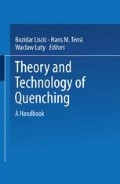Abstract
Quenching specialists have often noticed unaccountable variations among the results of that meaningful phase of heat treatment. Those at times epidemic-like variations entail poor hardness penetration and/or distortions.
Access this chapter
Tax calculation will be finalised at checkout
Purchases are for personal use only
Preview
Unable to display preview. Download preview PDF.
References
Dumont C et al. (1975) Principes de conception et de choix d’une huile de trempe. In: Traitement Thermique 94: 81–90.
Dumont C et al. (1975) Principes de conception et de choix d’une huile de trempe. In: Traitement Thermique 95: 67–75.
Moreaux F, Chevrier JC, Beck G (1976) Hydrodynamic and thermal study of the stability of the boundary layer in the case of film boiling. Proceedings of the I.C.H.M.T 29.8-4.9. Dubrovnik (Yougoslavie) 615-623.
Bradfield WS (1966) Solid-liquid contact in stable film boiling. In: I/E.C Fundamentals 5: 200–204.
Stevens JW, Witte LC (1971) Transient film and transition boiling from a sphere. In: Int. J. Heat and Mass Transfer 14: 443–450.
Stevens JW, Witte LC (1973) Destabilization of vapor film boiling around spheres. In: Int. J. Heat and Mass Transfer 14: 669–678.
Hoeje OC et al. (1975) An investigation of the collapse and surface rewet in film boiling in forced vertical flow. In: J. Heat Transfer: 166-172.
Vigneron B et al. (1982) Determination du pouvoir refroidissant d’huiles de trempe sous vide. In: Traitement Thermique 169: 37–39.
Flament G, Moreaux F, Beck G (1978) Instabilité de la caléfaction au cours du refroidissement par trempe dans l’eau sous-refroidie. C.R. Ac. Sc. 287B, 321–323.
Flament G, Moreaux F, Beck G (1979) Instabilité de la caléfaction à haute température sur an cylindre vertical trempé dans un liquide sousrefroidi. In: Int. J. Heat and Mass Transfer 22: 1059–1067.
Flament G, Moreaux F, Martin M (1979) Déstabilisation de la caléfaction: propagation du front de mouillage. In: Letters in Heat and Mass Transfer 6: 208–216.
Spiegler P et al. (1963) Onset on film boiling and the foam limit. In: Int. J. Heat and Mass Transfer 6: 987–989.
Beck G, Chevrier JC (1971) Comparaison des données de trempe, déterminées à l’aide d’une méthode numérique, à celles du régime permanent. In: Int. J. Heat and Mass Transfer 14: 1731–1735.
Archambault P, Chevrier JC (1977) Distribution de la température au sein d’un cylindre trempé dans un liquide vaporisable. In: Int. J. Heat and Mass Transfer 20: 1–6.
Flament G, Chevrier JC, Moreaux F (1977) Transfert de chaleur en mode transitoire entre un solide à haute température et l’eau bouillante. In: C. R. Ac. Sc. 284B: 339–342.
Beck G (1971) Contribution à l’étude thermocinétrique du régime initial de trempe des métaux et alliages. In: Revue Générale de Thermique 109: 37–34.
Chevrier JC, Moreaux F, Beck G (1972) L’effusivité et la résistance thermique des zones superficielles du solide déterminent le processus de vaporisation du liquide en régime de trempe. In: Int. J. Heat and Mass Transfer 15: 1631–1645.
Chevrier JC, Beck G (1971) Influence d’un dépôt de faible conductivité thermique sur le mécanisme de refroidissement par trempe d’une éprouvette métallique dans l’azote liquide. Application à la trempe à l’eau. In: Mémoires Scientifiques de la Revue de Métallurgie LXVIII 6: 391–400.
Moreaux F, Chevrier JC, Beck G (1975) Destabilization of film boiling by means of a thermal resistance. In: International Journal of Multiphase Flow 2, 183–190.
Kikuchi Y et al. (1986) The effect of thin insulating layer on heat transfer characteristics during quenching of hot metals in satured water. In: Transactions ISIJ 26: 576–581.
Archambault P et al. (1980) A contribution to the optimization of the 7075 heat treatment. In: Material Science and Engineering 43: 1–6.
Moreaux F, Simon A, Beck G (1980) Relations between quenching process, hardness depth and quench defects in steels. In: Heat Treating 1: 50–56.
Zavarine IN (1935) Quenching in water, brine and oil. In: Metal Progress 27: 43–46.
Moreaux F, Beck G (1970) Influence sur le pouvoir de refroidissement par trempe dans l’eau, de la mise en solution d’un sel thermiquement stable. In: Mémoires Scientifiques de la Revue de Métallurgie LXVII 4: 285–293.
Van Stralen SJD (1968) The growth rate of vapour bubbles in superheated pure liquids and binary mixtures. Int. J. Heat and Mass Transfer 11: 1467–1489.
Moreaux F et al. (1984) New polymer quenchants for steels and their characterisation by cooling curves and hardness penetration Heat Treatment’ 84. 2–4 Mai Londres (Angleterre) Proceedings 18.1-18.5.
Moreaux F et al. (1986) Nouvelles solutions aqueuses de polymères organiques pour la trempe des aciers et des alliages d’aluminium. Proceedings vol. III. 5éme ICHTM. 20–24 Octobre Budapest (Hongrie) p. 1799-1805.
Olivier J et al. (1986) Brassage des fluides de trempe: conception et conséquences métallurgiques. In: Traitement Thermique 206: 29–42.
Moreaux F et al. Procédé de modification du pouvoir refroidissant de milieux aqueux destinés à la trempe d’alliages métalliques. Brevet français no 87 18109. Brevet européen no 88 420422.3.
Moreaux F et al. (1988) New aqueous solutions for metallic alloys quenching. Importance of agitation. Proceedings 167-170. 6ème ICHTM. 28–30 September, Chigago (U.S.A).
Archambault P, Chevrier JC, Beck G (1978) Sur l’existence de refroidissements optimaux des pièces en alliage d’aluminium. C. R. Ac. Sc. 286: 139–142.
Editor information
Editors and Affiliations
Rights and permissions
Copyright information
© 1992 Springer Science+Business Media New York
About this chapter
Cite this chapter
Moreaux, F., Beck, G. (1992). Effect of Workpiece Surface Properties on Cooling Behaviour. In: Liščić, B., Tensi, H.M., Luty, W. (eds) Theory and Technology of Quenching. Springer, Berlin, Heidelberg. https://doi.org/10.1007/978-3-662-01596-4_7
Download citation
DOI: https://doi.org/10.1007/978-3-662-01596-4_7
Publisher Name: Springer, Berlin, Heidelberg
Print ISBN: 978-3-662-01598-8
Online ISBN: 978-3-662-01596-4
eBook Packages: Springer Book Archive

